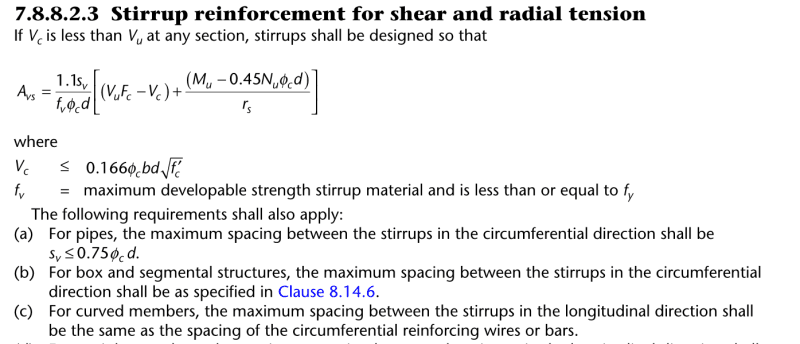Quade999
Civil/Environmental
- May 29, 2020
- 61
Hello Everyone,
I'm looking for clarification on the clause below.

From what I take is that this clause only applies if my ultimate shear exceeds my concrete shear resistance. The only thing that threw me off is that the clause provides a maximum value for Vc. If you calculate the shear resistance using sectional design it gives a larger resistance than the one shown here. Am I correct in assuming that the equation for Vc is just an upper bound for when using this clause only to plug into the equation to find the required stirrup area? i.e. if my ultimate shear is 300kN, and from sectional analysis I calculate Vc = 320kN, but the equation present here gives Vc = 280kN, this equation doesn't apply since I am comparing the 320kN resistance to the 300kN ultimate shear, and not the 280kN resistance to the 300kN ultimate.
I believe this is the case, but just clarifying. From the commentary below it seems that Vc in this clause is just an upper bound for the stirrup equation.

Thanks
I'm looking for clarification on the clause below.

From what I take is that this clause only applies if my ultimate shear exceeds my concrete shear resistance. The only thing that threw me off is that the clause provides a maximum value for Vc. If you calculate the shear resistance using sectional design it gives a larger resistance than the one shown here. Am I correct in assuming that the equation for Vc is just an upper bound for when using this clause only to plug into the equation to find the required stirrup area? i.e. if my ultimate shear is 300kN, and from sectional analysis I calculate Vc = 320kN, but the equation present here gives Vc = 280kN, this equation doesn't apply since I am comparing the 320kN resistance to the 300kN ultimate shear, and not the 280kN resistance to the 300kN ultimate.
I believe this is the case, but just clarifying. From the commentary below it seems that Vc in this clause is just an upper bound for the stirrup equation.

Thanks
